Seltos takes Kia on its own compact-SUV road
Filed under: Weekly test drives, Autos
By John Gilbert
The relationship between South Korean partners Kia and Hyundai has been interesting, if a bit confusing in the decade or so they’ve been united in a move by which Hyundai took in the struggling Kia operation. For awhile, it seemed that Kia simply got its own version of various Hyundai vehicles, but in recent years, Kia has boldly stepped out onto its own path.
There is no better example than the new Kia Seltos, a compact SUV that seems to be about the same size as Hyundai’s award-winning Kona. The Kona was named 2019 New Car Pick of the Year by newcarpicks.com, as well as numerous other evaluating sources. We are still evaluating our long-term Kona, which made it handy when a Neptune Blue 2021 Kia Seltos S Turbo showed up at our Duluth area home for a week’s test.
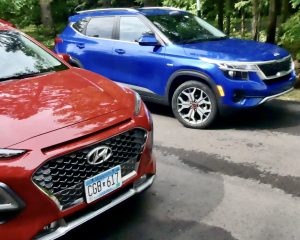
The Seltos is about 5 inches longer than the Hyundai Kona (left) and has more ground clearance, aimed for more rugged use.
Side-by-side, there are distinct differences, an objective the companies made a few years ago to use styling to differentiate, rather than copy. The Seltos is about 5 inches longer and about 2.5 inches taller, with those 2.5 inches used up by giving the Seltos about 7 inches of ground clearance, 2 more than the Kona.
The Seltos also has the unique Kia grille, under which is a very noticeable skid-plate, offering protection if you decide to do a little light off-roading.KWe were both impressed and puzzled by the Seltos S. Impressive was the sticker price, $26,740 with all options included, and also impressive was the Seltos S had a lot of punch from its 1.6-liter turbocharged 4 — the same engine that we got in the Kona. It has 175 horsepower at 6,000 RPMs, and a whopping 195 foot-pounds of torque at only 1,500 RPMs —a very good balance between the torque’s low-end punch and the horsepower’s cruising credits.
The all-wheel-drive system has a mode knob on the console, right next to the shift lever that governs the 7-speed dual-clutch automatic, and you can set it for normal, sport or eco. Enormously impressive is a switch that engages a downhill control, causing the engine to stay in a lower gear and aid you when descending hills without using only your brakes. In Duluth, where every avenue is a mile-high hill climb, meaning also a mile-down grade, that switch was eminently useful. The full array of safety gizmos are there, including a lane-departure system that includes lane-following, which keeps you centered in your lane, although not obtrusively. Read more
Mazda fits CX-30 between CX-3 and CX-5
Filed under: Weekly test drives, Autos
By John Gilbert
As purchasers of a vast array of automobiles, we in the U.S. have lost track of what passes for new technology. Some manufacturers spend more on advertising campaigns than on building better cars, because they are so addicted to bottom-line profits that they’re content to try to convince a naive public that the low-tech equipment they’ve restyled is actually the high-tech cars we seek.
Then there’s Mazda, a comparatively tiny manufacturer based in Hiroshima, Japan, but is loaded with brilliant engineers who not only stay on the cutting edge of technology but push the limits of what is possible to do with an automobile engine, while keeping its prices within reach of the average consumer, and also insisting that its cars maintain the simple belief that driving should be fun — embodied in the catch-phrase “Zoom-Zoom.”.
I recently got a chance to test-drive a Mazda CX-30 compact SUV, and it had so many advanced technical goodies built into it that I wasn’t sure what all it had.
Mazda already has an award-winning string of SUVs, from the compact CX-3, to the CX-5, and on up to the largest CX-9, and all of them over-achieve their targets. It didn’t seem that there wasn’t much of a gap between the smallest CX-3 and the CX-5 to squeeze another SUV between them, but Mazda thought differently. The CX-30 is right there, and sure enough, Mazda knew best, because the CX-30 relieves the concern that the CX-3 is almost but not quite big enough and that the CX-5 offers more room than a small family might need. The CX-5 is 179 inches long and the CX-3 measures 168 inches long, while the new CX-30 measures 173 inches in length — 5 inches longer than the CX-3 and 6 inches shorter than the CX-5.. The CX-30 wheelbase is 104.5 inches, 2.1 inches less than the CX-5.
I’m quite certain that anyone who considered either the CX-3 or CX-5 would find the CX-30 just right. Same with its pricer. It starts at the bargain rate of $21,900, although the test car was loaded up with what Mazda calls its Premium Package, which zooms the sticker up to $28,200 — still a bargain, particularly when you hear its ingredients.
It is fun to drive, quick and agile, and would probably be even quicker with only front-wheel drive. The test car had Mazda’s exceptional all-wheel drive, which may aid handling in the dry and certainly will in the wet or snow.
A couple years ago, Mazda engineers completed a decade of plotting, planning and developing to make its Zoom-Zoom go around corners even better than its standard of excellence in handling. To over-simplify, the idea of turning abruptly to go around a left turn, for example, common sense tells us we want to stiffen the outside wheel’s suspension and maybe give it an extra dose of power. Nay nay, says Mazda. Its engineers found exactly the opposite — if you start to turn in to the left and the power is reduced to the outside right front while its suspension is also softened just a bit, both for just a millisecond or two, you as the driver are emboldened that you’ve made the right choice to turn in at that spot. Read more
Lexus ES300h goes its own way — smoothly
Filed under: Weekly test drives, Autos
By John Gilbert
It’s become ingrained among auto critics to call cars built by Toyota “boring” and likening them to appliances,” which meant the Lexus luxury line models were probably “stylish appliances.” It’s going to take some adjusting, but those days have passed. When you examine the technical upswing of the 2020 models, it’s obvious those long-suffering cocoons have released a whole range of butterflies.
Toyota is such a huge company, with factories all around the world, building vehicles that were so trouble-free, the company reached the point of satisfaction. Everything Toyota built was basically bullet-proof as far as breakdowns were concerned, with strong, durable engines that would easily top 200,000 miles while housed in solid, safe vehicles.
Years slipped by, and competitors kept improving, but finally, a young man named Akio Toyoda became president of Toyota Motor Company. He is the grandson of Kiichiro Toyoda, the founder of Toyota Motors, but Akio is different. At age 64, he enjoyed sports and racing high-performance vehicles. And he determined that the boring title would be rendered to the scrap-heap, even if his company’s cars never seemed to suffer that fate.
He sent some new model designs back to the drawing board, demanding sportier exteriors to accompany the resurgence back to the cutting edge of technology it had seemed to abandon, while Honda, Mazda, Nissan, and South Korean newcomers Hyundai and Kia went right on by. Without a doubt, the new Camry, Corolla, RAV-4, and other models, and their accompanying ad campaigns, indicate new recipes are boiling up on the menu.
The 2020 Lexus ES 300, for example, had always been a stretched Camry with bling, but the new car I got for a test drive was not just any ES 300. It was an ES 300h Ultra Luxury, where the “h” stands for hybrid, and which shows that the Japanese may still need to bring their naming concepts up to the car’s new edge. This 300h is a long, low, slinky luxury liner, so “Ultra Luxury” is not inappropriate, if comparatively trite.
As you approach the car, the bold, sporty-car grille, sporting a new Lexus signature look, and blends into 6-headlight LED beams, and then that long, sensuous body. The grille itself, with its intricate fanning out of metal struts could probably hypnotize you if you stared at it long enough. It was placed on a new platform of its own one year ago, meaning the 2019 model got a head start on other Toyota and Lexus models making their way upward to new levels of stiffness and sophistication.
And while Toyota rules the world of hybrids with its ever-expanding Prius models, Toyota’s “Hybrid Synergy Drive” has spent a decade using nickel-metal-hydride battery packs, but the test car has “Lexus Hybrid Drive” includes a slick Lithium Ion battery pack that sits low and flat under the rear seat to leave extra room in the rear seat and the trunk.
With a new platform and an appealing body, the ES 300 gets a new powertrain, with a 2.5-liter 4-cylinder gasoline engine coupled to that electric system. Together, they provide 215 horsepower, a commendable blend of power and fuel economy. It’s one of those perception things — drive it, and use the paddle shifters on the beautifully designed steering wheel, and you will declare that the power is easily adequate for hauling your family around. Read more
Atlas Cross Sport fills VW’s SUV niche
Filed under: Weekly test drives, Autos
By John Gilbert
We were only a couple of days into our weeklong road test of the new 2020 Volkswagen Atlas Cross Sport when I turned south on 60th Avenue East from Superior Street toward London Road, and the Duluth gateway to the North Shore Drive. I was impressed by the Atlas, because pretty much everything is impressive with the SEL Premium model, and I hadn’t yet closely examined what makes the Cross Sport different from the garden-variety Atlas.
There is a hiking/biking trail that crosses 60th, just about 10 feet before you cross a set of railroad tracks. I was going about 20 miles per hour, no hurry, and not fast enough to give us any jolts from the railroad tracks.
Suddenly, there was a terrible noise and the Atlas Cross Sport lurched to a stop. Very sudden. Fortunately, I had experienced the same jolt in previous road tests, so I recovered my decorum right away. What it was, was what the VW information refers to as “forward collision detection and assist,” and this was definitely in the “assist” category. The finely discerning VW system with its radar, sonar, camera and computer system all coordinated, spotted the railroad tracks as a nasty enough hazard to help me decide that I shouldn’t just sail over it. It helped me decide by deciding for me, that I should be stopped, and then maybe creep over the hazard.
Pretty impressive safety item, particularly for objects you might not see in the road ahead, and it could prevent you from hitting somerhing you and your VW would be better off not hitting.
There are a lot of other neat features in the new Volkswagen Atlas Cross Sport, which is an intriguing look at what VW is thinking these days, but none of them makes a more abrupt impression.
Volkswagen came out with the Atlas a couple years ago, as a vehicle that sits taller than the Jetta or Passat, and is up there amid the segment already populated by VW’s two SUVs — the Tiguan and the Touareg — but which defies accurate description. Is it a wagon, or a bulky sedan, or a sleek SUV? The answer is: All of the above. Read more


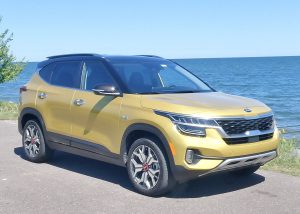
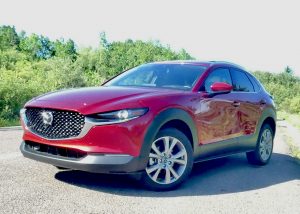
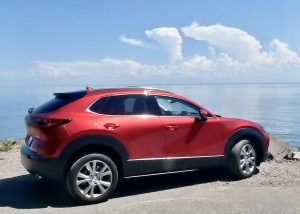
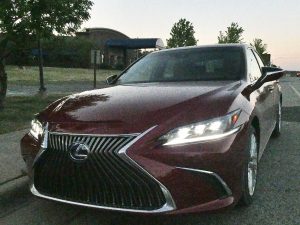
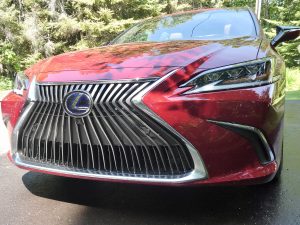
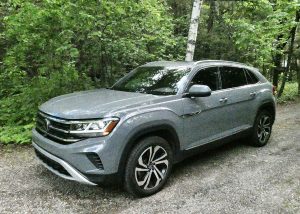
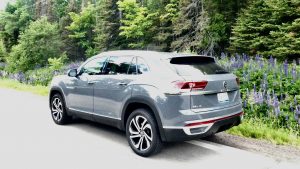
 John Gilbert is a lifetime Minnesotan and career journalist, specializing in cars and sports during and since spending 30 years at the Minneapolis Tribune, now the Star Tribune. More recently, he has continued translating the high-tech world of autos and sharing his passionate insights as a freelance writer/photographer/broadcaster. A member of the prestigious North American Car and Truck of the Year jury since 1993. John can be heard Monday-Friday from 9-11am on 610 KDAL(www.kdal610.com) on the "John Gilbert Show," and writes a column in the Duluth Reader.
John Gilbert is a lifetime Minnesotan and career journalist, specializing in cars and sports during and since spending 30 years at the Minneapolis Tribune, now the Star Tribune. More recently, he has continued translating the high-tech world of autos and sharing his passionate insights as a freelance writer/photographer/broadcaster. A member of the prestigious North American Car and Truck of the Year jury since 1993. John can be heard Monday-Friday from 9-11am on 610 KDAL(www.kdal610.com) on the "John Gilbert Show," and writes a column in the Duluth Reader.